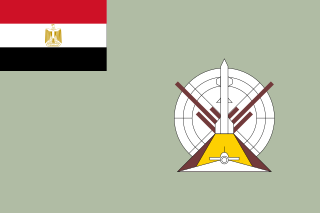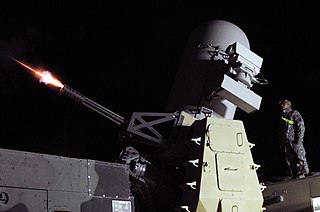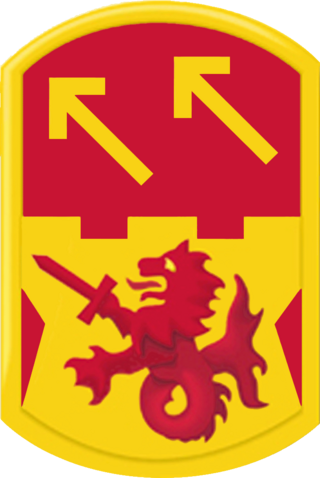
The MIM-104 Patriot is a mobile interceptor missile surface-to-air missile (SAM) system, the primary such system used by the United States Army and several allied states. It is manufactured by the U.S. defense contractor Raytheon and derives its name from the radar component of the weapon system. The AN/MPQ-53 at the heart of the system is known as the "Phased Array Tracking Radar to Intercept on Target," which is a backronym for "Patriot". In 1984, the Patriot system began to replace the Nike Hercules system as the U.S. Army's primary high to medium air defense (HIMAD) system and the MIM-23 Hawk system as the U.S. Army's medium tactical air defense system. In addition to these roles, Patriot has been given a function in the U.S. Army's anti-ballistic missile (ABM) system. As of 2016, the system is expected to stay fielded until at least 2040.

Starstreak is a British short-range surface-to-air missile that can be used as a man-portable air-defence system (MANPADS) or used in heavier systems. It is manufactured by Thales Air Defence in Belfast, Northern Ireland. It is also known as Starstreak HVM. After launch, the missile accelerates to more than Mach 4, making it the fastest short-range surface-to-air missile in existence. It then launches three laser beam-riding submunitions, increasing the likelihood of a successful hit on the target. Starstreak has been in service with the British Army since 1997. In 2012 Thales relaunched the system as ForceSHIELD.

The Avenger Air Defense System, designated AN/TWQ-1 under the Joint Electronics Type Designation System, is an American self-propelled surface-to-air missile system which provides mobile, short-range air defense protection for ground units against cruise missiles, unmanned aerial vehicles, low-flying fixed-wing aircraft, and helicopters.

The Raytheon MIM-23 HAWK is an American medium-range surface-to-air missile. It was designed to be a much more mobile counterpart to the MIM-14 Nike Hercules, trading off range and altitude capability for a much smaller size and weight. Its low-level performance was greatly improved over Nike through the adoption of new radars and a continuous wave semi-active radar homing guidance system. It entered service with the US Army in 1959.

The AN/MPQ-64 Sentinel is an X-band electronically steered pulse-Doppler 3D radar system used to alert and cue Short Range Air Defense (SHORAD) weapons to the locations of hostile targets approaching their front line forces. It is currently produced by Raytheon Missiles & Defense.

NASAMS is a distributed and networked short- to medium-range ground-based air defense system developed by Kongsberg Defence & Aerospace (KDA) and RTX Corporation. The system defends against unmanned aerial vehicles (UAVs), helicopters, cruise missiles, unmanned combat aerial vehicles (UCAVs), and fixed wing aircraft, firing any of a wide range of existing missiles.

The Egyptian Air Defence Forces (EADF) is the Anti-aircraft warfare branch of the Egyptian Armed Forces. It is responsible for protecting the Egyptian airspace against any hostile air attacks. The EADF was established in accordance with the presidential decree issued on 1 February 1968, which established the Air Defence Forces as the fourth branch, next to the Navy, Egyptian Ground Forces, and Egyptian Air Force. From 1938 onwards air defence forces had been part of the artillery and under the operation command of the Air Force. Egypt has a modern system of air defence armament, which is divided between anti-aircraft missiles long, medium and short-range anti-aircraft artillery systems and early warning radars. Both Western and Soviet bloc countries have supplied equipment.

The 16th Regiment, Royal Australian Artillery is the Australian Army's only ground-based air defence (GBAD) unit. It also provides sense, warn and locate, ground liaison, and joint terminal attack control capabilities. Part of the Royal Regiment of Australian Artillery (RAA), the regiment is responsible for protecting a wide range of military assets during wartime, ranging from Army units in the field to providing point defence to the Royal Australian Navy's support ships and air defence to Royal Australian Air Force air bases. Prior to being equipped with the currently in-service RBS 70 surface-to-air missile system, the regiment was equipped with the Rapier systems for 25 years. The regiment is based at Woodside, South Australia, but frequently deploys with other Australian and allied units on operations and defence exercises. The regiment is part of the 6th Combat Support Brigade.

Counter rocket, artillery, and mortar, abbreviated C-RAM or counter-RAM, is a set of systems used to detect and/or destroy incoming rockets, artillery, and mortars before they hit their targets, or provide early warning.

Short range air defense (SHORAD) is a group of anti-aircraft weapons and tactics that have to do with defense against low-altitude air threats, primarily helicopters and low-flying aircraft such as the A-10 or Sukhoi Su-25. SHORAD and its complements, HIMAD and THAAD divide air defense of the battlespace into domes of responsibility based on altitude and defensive weapon ranges.

Lieutenant General Best Barracks, formerly De Peel Air Base, is a Royal Netherlands Army guided missile base in the Netherlands. It has only one, though not actively used, runway.

The 94th Army Air and Missile Defense Command is an activated Air Defense Artillery command of the United States Army assigned to United States Army Pacific. It is headquartered at Joint Base Pearl Harbor–Hickam, Hawai'i at the Pacific Air Force Headquarters.

The SLAMRAAM (Surface Launched AMRAAM) was the United States Army program to develop a Humvee-based surface-to-air missile launcher for the AIM-120 AMRAAM missile, manufactured by Raytheon Technologies and Kongsberg Defence & Aerospace. Surface-launched AMRAAM missile was first used in Kongsberg's NASAMS air defense system, fielded in 1995.

Fourth Allied Tactical Air Force was a NATO military formation under Allied Air Forces Central Europe tasked with providing air support to NATO's Central Army Group (CENTAG) in the southern portion of West Germany. 4 ATAF commanded all flying units based within its sector and all reinforcements flying into its sector, as well as ground-based radar systems and stations, air defense units and the airfields in its sector.

The Joint Ground Based Air Defence Headquarters or JtGBAD HQ was a joint (non-deployable), force-generating British military formation under the operational command of RAF Air Command, sitting under No.1 Group. It was formed circa 2000 and disbanded in 2019 in favour of 7th Air Defence Group.

The current structure of the Royal Netherlands Army is as follows:

The Joint Ground-based Air Defence Command is a joint command of the Royal Netherlands Army, formed in 2012 after amalgamation of the Commando Luchtdoelartillerie of the Royal Netherlands Army and the Groep Geleide Wapens of the Royal Netherlands Air Force. The command is responsible for all ground-based air defence tasks and consists of both army and air force personnel. The DGLC employs an integrated layered air-defence approach featuring FIM-92 Stinger, NASAMS II and MIM-104 Patriot systems.

The Operational Support Command Land is a support command of the Royal Netherlands Army. The command consists of multiple combat support and combat service support units that provide the army with a broad variety of services. The OOCL was established in 2009, with the simultaneous disbandment of 1 Logistics Brigade and 101 Combat Support Brigade.

The Fire Support Command is the artillery arm of the Royal Netherlands Army. The command consists of 41 Artillery Battalion, a staff, the Fire Support School and the artillery training grounds and is part of the Operational Support Command Land.

The ACSV G5 G5 is a family of light tracked vehicles designed and manufactured by Flensburger Fahrzeugbau GmbH (FFG) of Germany. Although it is similar in appearance and design to the American M113, and the company manufacturers modernised versions of that vehicle, the PMMC G5 is an all-new ground-up design.




















